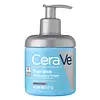What's inside
What's inside
 Key Ingredients
Key Ingredients

 Benefits
Benefits

 Concerns
Concerns

 Ingredients Side-by-side
Ingredients Side-by-side

Salicylic Acid 2%
MaskingWater
Skin ConditioningUrea
BufferingGlyceryl Stearate Se
EmulsifyingCetearyl Alcohol
EmollientButyrospermum Parkii Butter
Skin ConditioningGlycerin
HumectantNiacinamide
SmoothingCetyl Alcohol
EmollientPEG-100 Stearate
Limnanthes Alba Seed Oil
Skin ConditioningLaureth-9
EmulsifyingGossypium Herbaceum Seed Oil
Skin ConditioningBehentrimonium Methosulfate
C12-13 Alkyl Lactate
Emollient1,2-Hexanediol
Skin ConditioningDimethicone
EmollientCeramide NP
Skin ConditioningCeramide AP
Skin ConditioningCeramide EOP
Skin ConditioningCarbomer
Emulsion StabilisingGlyceryl Stearate
EmollientSodium Hydroxide
BufferingSodium Lauroyl Lactylate
EmulsifyingCholesterol
EmollientTasmannia Lanceolata Fruit/Leaf Extract
AntioxidantPhenoxyethanol
PreservativeDisodium EDTA
Tocopherol
AntioxidantHydroxyacetophenone
AntioxidantHydrogenated Olive Oil
Skin ConditioningHydrolyzed Hyaluronic Acid
HumectantCitric Acid
BufferingPhytosphingosine
Skin ConditioningXanthan Gum
EmulsifyingEthylhexylglycerin
Skin ConditioningSalicylic Acid 2%, Water, Urea, Glyceryl Stearate Se, Cetearyl Alcohol, Butyrospermum Parkii Butter, Glycerin, Niacinamide, Cetyl Alcohol, PEG-100 Stearate, Limnanthes Alba Seed Oil, Laureth-9, Gossypium Herbaceum Seed Oil, Behentrimonium Methosulfate, C12-13 Alkyl Lactate, 1,2-Hexanediol, Dimethicone, Ceramide NP, Ceramide AP, Ceramide EOP, Carbomer, Glyceryl Stearate, Sodium Hydroxide, Sodium Lauroyl Lactylate, Cholesterol, Tasmannia Lanceolata Fruit/Leaf Extract, Phenoxyethanol, Disodium EDTA, Tocopherol, Hydroxyacetophenone, Hydrogenated Olive Oil, Hydrolyzed Hyaluronic Acid, Citric Acid, Phytosphingosine, Xanthan Gum, Ethylhexylglycerin
Water
Skin ConditioningGluconolactone
Skin ConditioningHydroxyethyl Urea
HumectantButyrospermum Parkii Butter Extract
Skin ConditioningCetyl Alcohol
EmollientAmmonium Lactate
BufferingPetrolatum
EmollientPotassium Hydroxide
BufferingPropanediol
SolventSalicylic Acid
MaskingDimethicone
EmollientGlyceryl Stearate
EmollientSteareth-21
CleansingAloe Barbadensis Leaf Juice
Skin ConditioningJojoba Esters
EmollientTheobroma Cacao Seed Butter
EmollientCaprylyl Methicone
Skin ConditioningPolyacrylate Crosspolymer-6
Emulsion StabilisingPPG-3 Benzyl Ether Myristate
EmollientCitrus Limon Fruit Extract
MaskingCitrus Aurantium Dulcis Fruit Extract
MaskingPyrus Malus Fruit Extract
Skin ConditioningSaccharum Officinarum Extract
MoisturisingZingiber Officinale Root Extract
MaskingCamellia Sinensis Leaf Extract
AntimicrobialTocopheryl Acetate
AntioxidantMagnesium Ascorbyl Phosphate
AntioxidantPanthenol
Skin ConditioningBisabolol
MaskingPolyglyceryl-4 Laurate/Succinate
Stearamidopropyl Pg-Dimonium Chloride Phosphate
Phenoxyethanol
PreservativePropylene Glycol
HumectantHydroxyethylcellulose
Emulsion StabilisingWater, Gluconolactone, Hydroxyethyl Urea, Butyrospermum Parkii Butter Extract, Cetyl Alcohol, Ammonium Lactate, Petrolatum, Potassium Hydroxide, Propanediol, Salicylic Acid, Dimethicone, Glyceryl Stearate, Steareth-21, Aloe Barbadensis Leaf Juice, Jojoba Esters, Theobroma Cacao Seed Butter, Caprylyl Methicone, Polyacrylate Crosspolymer-6, PPG-3 Benzyl Ether Myristate, Citrus Limon Fruit Extract, Citrus Aurantium Dulcis Fruit Extract, Pyrus Malus Fruit Extract, Saccharum Officinarum Extract, Zingiber Officinale Root Extract, Camellia Sinensis Leaf Extract, Tocopheryl Acetate, Magnesium Ascorbyl Phosphate, Panthenol, Bisabolol, Polyglyceryl-4 Laurate/Succinate, Stearamidopropyl Pg-Dimonium Chloride Phosphate, Phenoxyethanol, Propylene Glycol, Hydroxyethylcellulose
 Reviews
Reviews

Ingredients Explained
These ingredients are found in both products.
Ingredients higher up in an ingredient list are typically present in a larger amount.
Cetyl Alcohol is a fatty alcohol. Fatty Alcohols are most often used as an emollient or to thicken a product.
Its main roles are:
Though it has "alcohol" in the name, it is not related to denatured alcohol or ethyl alcohol.
The FDA allows products labeled "alcohol-free" to have fatty alcohols.
Learn more about Cetyl AlcoholDimethicone is a type of synthetic silicone created from natural materials such as quartz.
What it does:
Dimethicone comes in different viscosities:
Depending on the viscosity, dimethicone has different properties.
Ingredients lists don't always show which type is used, so we recommend reaching out to the brand if you have questions about the viscosity.
This ingredient is unlikely to cause irritation because it does not get absorbed into skin. However, people with silicone allergies should be careful about using this ingredient.
Note: Dimethicone may contribute to pilling. This is because it is not oil or water soluble, so pilling may occur when layered with products. When mixed with heavy oils in a formula, the outcome is also quite greasy.
Learn more about DimethiconeGlyceryl Stearate is a mix of glycerin and stearic acid.
It is used to stabilize the mixing of water and oil ingredients. By preventing these ingredients from separating, it can help elongate shelf life. It can also help thicken the product's texture.
As an emollient, it helps soften skin and supports barrier-replenishing ingredients.
In cosmetics, Glyceryl Stearate is often made from vegetable oils or synthetically produced.
This ingredient may not be fungal-acne safe
Fun fact: The human body also creates Glyceryl Stearate naturally.
Learn more about Glyceryl StearatePhenoxyethanol is a preservative that has germicide, antimicrobial, and aromatic properties. Studies show that phenoxyethanol can prevent microbial growth. By itself, it has a scent that is similar to that of a rose.
It's often used in formulations along with Caprylyl Glycol to preserve the shelf life of products.
Salicylic Acid (also known as beta hydroxy acid or BHA) is a well-known ingredient for treating skin that struggles with acne and clogged pores. It exfoliates both the skin's surface and deep within the pores to help clear out buildup, control oil, and reduce inflammation.
Unlike AHAs (alpha hydroxy acids), salicylic acid is oil-soluble. This allows it to penetrate into pores which makes it especially effective for treating blackheads and preventing future breakouts.
Salicylic acid is also known for its soothing properties. It has a similar structure to aspirin and can calm inflamed or irritated skin, making it a good option for acne-prone skin that is also sensitive.
Concentrations of 0.5-2% are recognized by the U.S. FDA as an over-the-counter topical acne product.
It can cause irritation and/or dryness if one's skin already has a compromised moisture barrier, so it's best to focus on repairing that before introducing this ingredient into your routine.
While salicylic acid does not increase sun sensitivity, it’s still important to wear sunscreen daily to protect your skin.
If you are looking for the ingredient called BHA or Butylated Hydroxyanisole, click here.
Learn more about Salicylic AcidWater. It's the most common cosmetic ingredient of all. You'll usually see it at the top of ingredient lists, meaning that it makes up the largest part of the product.
So why is it so popular? Water most often acts as a solvent - this means that it helps dissolve other ingredients into the formulation.
You'll also recognize water as that liquid we all need to stay alive. If you see this, drink a glass of water. Stay hydrated!
Learn more about Water